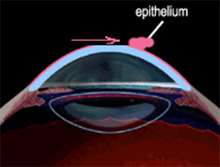
LASEK (laser epithelial Keratomileusis) is a relatively new procedure that is technically a variation of PRK. It is also called epithelial LASIK or E-LASIK. LASEK is used mostly for people with corneas that are too thin or too flat for LASIK. It was developed to reduce the chance of complications that occur when the flap created during LASIK is not the ideal thickness or diameter.
The LASEK Procedure
In LASEK, the epithelium, or outer layer of the cornea, is cut not with the Microkeratome cutting tool used in LASIK, but with a finer blade called a trephine. Then the surgeon covers the eye with an alcohol solution (perhaps one part alcohol and four parts sterile water) for around 30 seconds. The solution loosens the edges of the epithelium.
After sponging the alcohol solution from the eye, the surgeon uses a tiny hoe to lift the edge of the epithelial flap and gently folds it back out of the way. Then he uses an Excimer laser, as in LASIK, to sculpt the corneal tissue underneath. Afterward, the epithelial flap is placed back on the eye with a kind of spatula.
After LASEK
In many ways, what you can expect from LASEK is similar to what you can expect from LASIK, but there are some differences. According to doctors who perform LASEK, the flap edge heals in about a day, though patients usually wear a bandage contact lens for around four days. You may feel eye irritation during the first day or two afterward. Also, the time it takes to recover good vision is often longer — up to four to seven days. Of course, it varies from one person to the next.
If you are considering LASIK, but your doctor says you need LASEK instead, ask why. It’s not for everyone, but many surgeons who perform LASEK consider it a better option for some patients who will probably not do very well with LASIK
Read More
Read More
Read More
Read More






